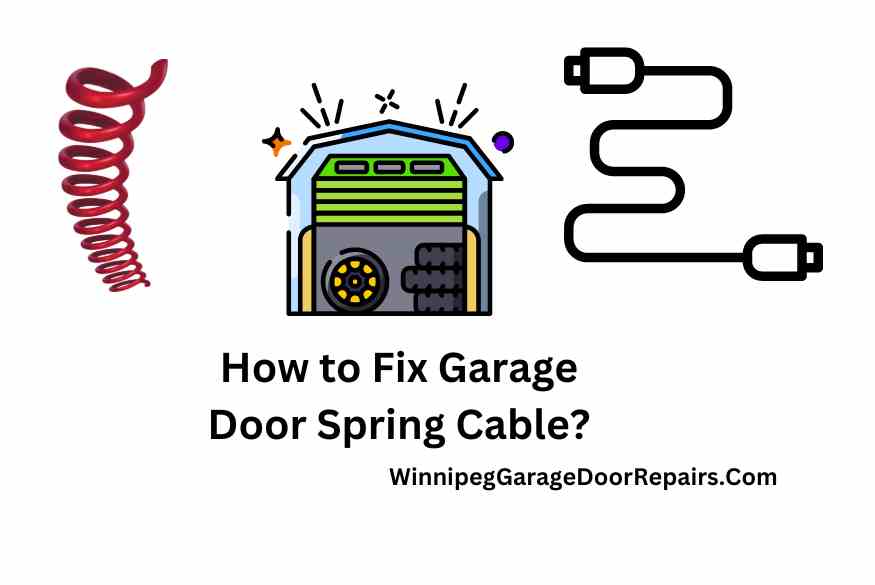Ever tried opening your garage door, only to find it stubbornly refuses to move? It’s a frustrating situation that many homeowners encounter, often due to a broken spring. Among the types of springs, the garage door torsion spring is particularly crucial for the smooth operation of the door.
Recognizing the signs of a broken spring is essential for timely repairs, ensuring your door functions safely and efficiently. Understanding the specific issues related to a torsion spring can help you identify problems more accurately. Let’s explore the 11 key indicators that your garage door spring might need attention, keeping in mind the unique characteristics of torsion springs and their role in your garage door’s mechanism.
Understanding the Basics
Before diving into the repair process, it’s important to understand what a garage door spring cable is and why it’s so vital. The spring cable is part of the counterbalance system that makes it possible to open and close your heavy garage door with ease.
This system uses either torsion springs, located above the door, or extension springs, located alongside the upper tracks, to balance the door’s weight. The cables, attached to the bottom corners of the door, wind and unwind around drums or pulleys, helping to lift and lower the door smoothly.
Safety First
“Safety cannot be overstated when working on garage doors, especially if an extension spring on a garage door is broken. The springs are under a lot of tension, and if handled improperly, they can cause serious injury. Before starting any repair, ensure the garage door is closed and disconnected from the opener. Secure the door in place using clamps or locking pliers on the tracks to prevent it from moving. Always wear safety glasses and gloves to protect yourself during the repair process.”
Tools and Materials
Gathering the right tools and materials before starting will make the repair process smoother. You’ll need:
- Locking pliers
- Wrench set
- Winding bars (for torsion springs)
- A new garage door spring cable
- A ladder
Ensure the replacement cable is the correct length and thickness for your garage door model. Using the wrong cable can lead to further issues down the line.
Step 1: Releasing Tension in the Spring
For torsion springs, you’ll need to carefully unwind the spring using winding bars. Insert the bars into the winding cone and slowly release the tension. For extension springs, secure the door and carefully disconnect the spring from the track bracket.
Step 2: Removing the Damaged Cable
Once the tension is released, you can safely remove the damaged cable. Detach it from the bottom bracket on the door, then unhook it from the drum or pulley system. Take this opportunity to inspect the pulleys and drums for wear and replace them if necessary.
Step 3: Installing the New Cable
Thread the new cable through the pulley system, following the path of the old cable. Attach one end to the bottom bracket on the door, then wind the other end around the drum or pulley. Ensure the cable is seated properly in the grooves to prevent it from slipping.
Step 4: Adjusting Tension
This step is crucial for the smooth operation of your door. For torsion springs, wind the spring using the winding bars until the proper tension is achieved. For extension springs, reattach the spring to the track bracket and adjust the tension as needed. The door should balance evenly and stay in place when opened halfway.
Step 5: Testing and Fine-tuning
Carefully remove the clamps or locking pliers and manually test the door’s movement. It should open and close smoothly, with minimal effort. If the door feels heavy or unbalanced, you may need to adjust the spring tension further.
Maintenance Tips
Regular maintenance can prevent future issues with your garage door. Lubricate the springs, cables, and pulleys with a silicone-based lubricant every few months. Specifically, paying attention to the fact that garage door springs are broken is crucial. Inspect the system for signs of wear and tighten any loose hardware, ensuring the tracks are clean and aligned for smooth operation.
Conclusion
Fixing a garage door spring cable is a manageable DIY project with the right preparation and care. This guide has walked you through each step of the process, from safety precautions to tension adjustment. By following these instructions, you can restore the functionality of your garage door and ensure its safe operation. Remember, regular maintenance is key to avoiding future problems. And if you ever feel out of your depth, don’t hesitate to call a professional garage door technician for help.







